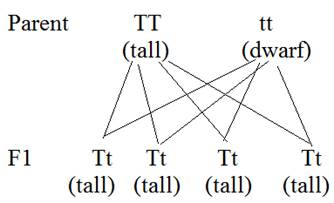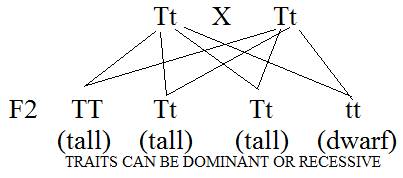In one of his experiments with pea plants, Mendel observed that when a pure tall pea plant is crossed with a pure dwarf pea plant, in the first generation, F1 only tall plants appear.
i. What happens to the traits of the dwarf plants in this case?
ii. When the F1 generation plants were self-fertilised, he observed that in the plants of the second generation, F2 both tall plants and dwarf plants were present. Why it happened? Explain briefly.
I. When a pure tall pea plant (TT) is crossed with a pure dwarf pea plant (tt), the result of F1 progeny is given in the diagram below:

• In the cross above the allele (T) becomes dominant over the other allele (t) making it recessive.
• When the dominant allele T from the tall pea plant is paired with the recessive allele t of the dwarf pea plant, the result in the genotype is Tt.
• In Tt, T is dominant over the t.
Hence, in F1 generation the dwarf traits become recessive making tall trait as dominant, and all the plants in the progeny will be tall.
II. When F1 generation is self-fertilized the cross obtained is given below:

When F1 generation is self-fertilized the progeny of F2 is both tall and dwarf due to the following reason:
• The genotype of the parents of F1 generation is Tt, which means dominant as well as recessive both traits are present in the allele. The plant will be tall as tallness is a dominant trait.
• When T from 1st tall pea plant is crossed with T from the 2nd tall pea plant, the genotype of the progeny is TT, having both the dominant allele, resulting in homozygous condition. Hence, it is without doubt phenotypically tall.
• When T (from the 1st plant) is crossed with t (from the 2nd plant), the result is Tt, resulting in heterozygous conditions. In such case, only dominant traits can express, making the plant tall.
• When t (from the 1st plant) is crossed with T (from the 2nd plant), it will again form a heterozygous condition, making the plant tall.
• When t (from the 1st plant) is crossed with t (from the 2nd plant), the result in the genotype is tt. The recessive allele will be able to express itself only in homozygous condition. Hence, because the allele has homozygous tt conditions, the plant will be dwarf.
Hence, due to the presence of homozygous alleles (TT, tt) and heterozygous alleles (Tt, Tt), the progeny of the F2 generation will be both tall and dwarf.